#the biodiversity saga
Text
Things to Do that Aren't Related to Growing Plants
This is my second post in a series I’ll be making on how to increase biodiversity on a budget! I’m not an expert--just an enthusiast--but I hope something you find here helps!
Some of us just don’t have much luck when it comes to growing plants. Some of us simply want to aim for other ways to help that don’t involve putting on gardening gloves. Maybe you've already got a garden, but you want to do more. No problem! There’s a couple of options you can look into that’ll help attract wildlife in your area without even having to bring out any shovels!
Provide a Water Source
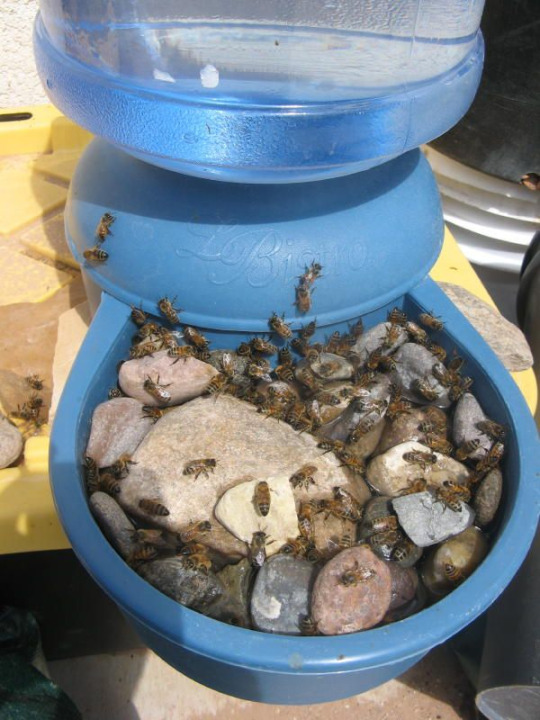
Oftentimes when I see ‘add a water source’ in informational articles about improving your backyard for wildlife, it’s almost always followed by an image of a gorgeous backyard pond with a waterfall and rock lining that looks expensive to set up, difficult to maintain, and overall just… not feasible for me. Arguably, not feasible for a lot of people. And that’s okay! There’s still ways to add water in your garden for all kinds of creatures to enjoy!
There’s tons of ways to create watering stations for insects like bees and butterflies. A self refilling dog bowl can work wonders! Add some stones into the receiving tray for insects to land on or use to climb out, and you’ve got a wonderful drinking spot for all kinds of insects! You can also fill a saucer or other dish with small stones and fill it, though it’ll likely need refilling daily or even several times a day during hot times.

I've seen people online use all kinds of things to make water features. Some go with terra-cotta pots, pebbles, and a cheap pump to get a small and simple fountain. Others use old tires, clay, and a hole in the ground to create an in-ground mini pond system. If all else fails, even a bucket or watertight box with a few plants in it can do the trick--though do be wary of mosquitoes if the water isn’t moving. In situations like these, a solar-powered fountain pump or bubbler are great for keeping the water moving while still making it a drinking option for wildlife (it not even more appealing for some)--and these items can be obtained fairly cheap online!

Bird baths are an option as well--a classic way to provide for birds in your area, they can be easy to find online or in a gardening store! The only downside is that a good, quality bird bath can be pricey up-front. However, a nice stone bird bath should last a long time, be easy to clean and refill, and be enjoyed by many birds! I’ve also seen tutorials on how to make your own with quickcrete! Bird baths will be a welcome sight to birds, as they provide a space for them to drink and bathe to regulate the oils in their feathers for flight and insulation. Putting a stone in the middle will also help insects to escape if they fall in, and provide a place to perch so they can get their own drink. You’ll want to change the water and clean the baths regularly--as often as once a week, if you can manage it.
If possible, it’s highly encouraged to fill and refill water features with rainwater instead of tap water. Tap water is often treated, so instead of using hoses or indoor kitchen water, collecting some rainwater is a great alternative. Collecting rainwater can be as simple as leaving cups, bins, or pots outside for awhile.
Butterflies and other creatures will also drink from mud puddles. If you can maintain an area of damp soil mixed with a small amount of salt or wood ash, this can be fantastic for them! Some plants also excel at storing water within their leaves and flowers (bromeliads come to mind), making them an excellent habitat for amphibians as well as a drinking spot for insects and birds.
Bird Feeders and Bird Houses

Some of the fancy, decorated bird feeders are expensive, but others can be pretty low-cost--I got my bird feeder from Lowe’s for around 10 dollars, and a big bag of birdseed was around another 10 dollars and has lasted several refills! If you don’t mind occasionally buying more birdseed, a single birdfeeder can do a lot to attract and support local birds! If you’re handy, have some spare wood, and have or can borrow some tools, you may even be able to find instructions online to make your own feeder. You may not even need wood to do so! Even hummingbird feeders, I’ve found, are quick to attract them, as long as you keep them stocked up on fresh sugar water in the spring and summer!
An important note with bird feeders is that you have to make sure you can clean them regularly. Otherwise, they may become a vector for disease, and we want to avoid causing harm whenever possible. Also keep an ear out and track if there’s known outbreaks of bird diseases in your area. If local birding societies and scientists are advising you take your birdfeeders down for awhile, by all means, do it!

Bird houses are naturally paired with bird feeders as biodiversity promoters for backyard spaces, and it makes sense. Having bird houses suited to birds in your area promotes them to breed, raise their young, disperse seeds, and generally engage in your surrounding environment. Setting them up takes careful selection or construction, preparation, and some patience, but sooner or later you might get some little homemakers! Keep in mind, you will need to clean your birdhouses at least once a year (if not once per brood) to make sure they’re ready and safe for birds year after year--you wouldn’t want to promote disease and parasites, after all. But they could be a valuable option for your landscape, whether you purchase one or construct your own!
Again, do make sure you're putting up the right kind of boxes for the right kinds of birds. Bluebird boxes are some I see sold most commonly, but in my area I believe they're not even all that common--a nesting box for cardinals or chickadees would be far more likely to see success here! And some birds don't even nest in boxes--robins and some other birds are more likely to use a nesting shelf, instead! Research what birds live in your area, take note of any you see around already, and pick a few target species to make homes for!
Solitary Bee Houses

A bee house or bee hotel is a fantastic way to support the solitary bees in your area! For a few dollars and some annual cleaning, you can buy a solitary bee house from most big box nurseries. Alternatively, you can make one at home, with an array of materials you may already have lying around! You can even make them so that they’ll benefit all kinds of insects, and not necessarily just bees.
Though you don’t even necessarily have to break out the hammer and nails, buy a ton of bricks, or borrow a staple gun. Making homes for tunneling bees can be as simple as drilling holes in a log and erecting it, or drilling holes in stumps and dead trees on your property. You might even attract some woodpeckers by doing this!
Providing Nesting Area
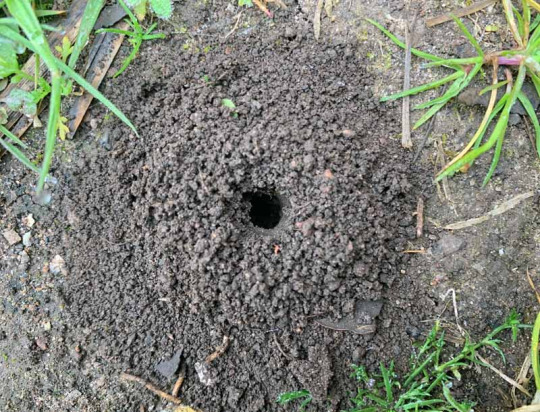
There are tons of different kinds of bees, and they all make different kinds of homes for themselves. Not all of them make big cavity hives like honey bees, or will utilize a solitary bee house. Bumblebees live in social hives underground, particularly in abandoned holes made by rodents--some others nest in abandoned bird nests, or cavities like hollow logs, spaces between rocks, compost piles, or unoccupied birdhouses. Borer, Ground, and Miner bees dig into bare, dry soil to create their nests. Sparsely-vegetated patches of soil in well-drained areas are great places to find them making their nests, so providing a similar habitat somewhere in the garden can encourage them to come! I do talk later in this document about mulching bare soil in a garden--however, leaving soil in sunny areas and south-facing slopes bare provides optimal ground nesting habitat. Some species prefer to nest at the base of plants, or loose sandy soil, or smooth-packed and flat bare ground. They’ve also been known to take advantage of soil piles, knocked over tree roots, wheel ruts in farm roads, baseball diamonds and golf course sand traps. You can create nesting ground by digging ditches or creating nesting mounds in well-drained, open, sunny areas with sandy or silty soil. However, artificially constructed ground nests may only have limited success.
Providing Alternative Pollinator Foods
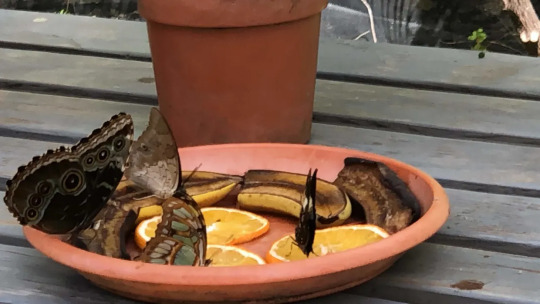
Nectar and pollen aren’t the only foods sought out by some pollinators! Some species of butterflies are known to flock to overripe fruit or honey water, so setting these out can be an excellent way to provide food to wildlife. You may want to be cautious about how you set these out, otherwise it can help other wildlife, like ants or raccoons. Butterflies may also drop by to visit a sponge in a dish of lightly salted water.
Bat Houses and Boxes
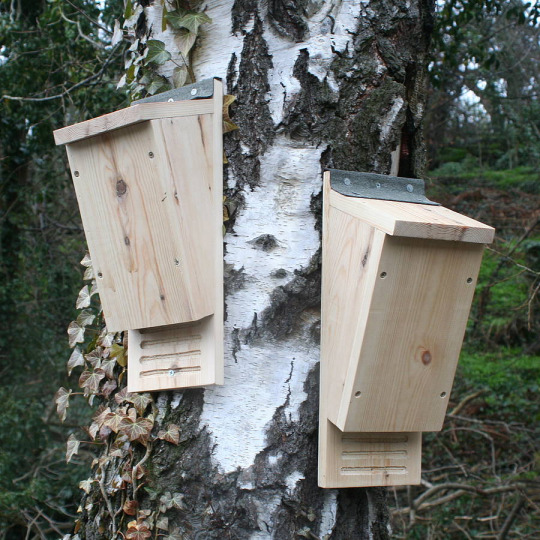
Big or small, whether they support five bats or five hundred, making bat boxes and supporting local bats is a great way to boost biodiversity! Not only will they eat mosquitoes and other pest species, but you may also be able to use the guano (bat droppings) as fertilizer! Do be careful if you choose to do that though--I’ve never had the opportunity to, so do some research into how strong it is and use it accordingly.
Provide Passageway Points
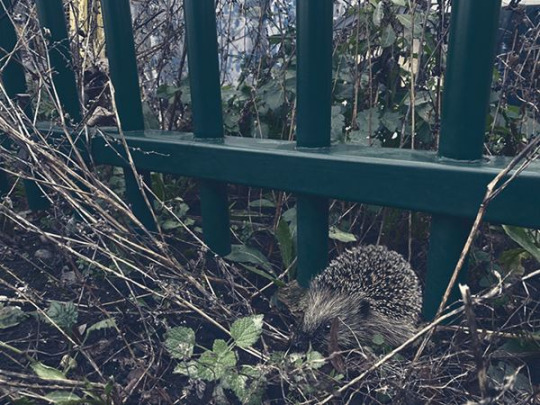
If you want your area to be more accessible for creatures that can’t fly or climb fences, allowing or creating access points can be an excellent way to give them a way in and out. Holes in the bottom of walls or fences can be sheltered with plants to allow animals through.
In a somewhat similar manner, if you’re adding a water fixture, it’s important to provide animals a way to get into and out of the pond--no way in, and they can’t use the water. No way out, and they may drown. Creating a naturalistic ramp out of wood beams or sticks, or stepped platforms out of bricks, stones, or logs can do the trick.
Get or Keep Logs and Brush Piles

I’ve already mentioned logs a good handful of times so far in this post. To be used as access ramps, or as nesting areas for solitary bees. But they have value as much more than that! Logs on the ground provide shelter for all kinds of animals, especially depending on size--anything from mice, reptiles, and amphibians to things like turkey vultures and bears will use fallen logs as shelter. Inside of a decaying log, there’s a lot of humidity, so amphibians are big fans of them--meanwhile, the upper sides of them can be used as sunning platforms by things like lizards. Other animals can also use the insides of logs as nest sites and hiding places from predators too big to fit inside. Fungi, spiders, beetles, termites, ants, grubs, worms, snails, slugs, and likely much more can be found inside rotting logs, using the rotting wood as food sources or nesting places. They can then provide food for mammals, amphibians, reptiles, and birds. They can also be regarded as a landmark or territory marker as wildlife get more familiar with your space.
So how do you get logs for cheap? Try Chip Drop! I talk about them more in a future post, but you can mark saying that you’d like logs in your drop, so they’ll give you any they have! In fact, you may even get a drop faster if you're willing to accept some logs. You may also be able to approach arborists you see working in your area and ask for logs. There may also be local online listings for people selling logs for cheap, or just trying to get rid of them. If there’s land development going on near you, you may be able to snag logs from trees they cut down to make space. Do keep in mind, you don’t need to have huge gigantic logs laying around your property to make an impact--even small logs can help a lot.

If possible, creating and leaving brush piles on the edge of your property can be a great boost to biodiversity--even if you may not see the wildlife using it. They’ll provide shelter from weather and predators, and lower portions are cool and shady for creatures to avoid the hot sun. The upper layers can be used as perch sites and nest sites for song birds, while lower layers are resting sites for amphibians and reptiles, and escape sites for many mammals. As the material decays, they also attract insects, and as such they’ll attract insect-eating animals too. As more small animals find refuse in your brush pile, their predators will be attracted to them as well. Owls, hawks, foxes, and coyotes are known to visit brush piles to hunt. Making a brush pile can be as simple as piling branches and leaves into a mound, as big or as small as you want. You can even use tree stumps or old fence posts near the base, and keep stacking on plant trimmings and fallen branches. Do note that you don’t want to do this near anything like a fire pit.
Don't forget, with all of these, your mileage may vary for any variation of reasons, so don't worry if you can't take all of even any of these actions! Even just talking about them with other people may inspire someone else to put out a bat box, or leave a few logs out for wildlife!
That's the end of this post! My next post is gonna be about ways to get seeds and plants as cheaply as possible. For now, I hope this advice helps! Feel free to reply with any questions, success stories, or anything you think I may have forgotten to add in!
#biodiversity#solarpunk#environmental stewardship#gardening#outdoor gardening#(i know this is literally the Dont Gotta Garden post but these could also be excellent additions to a preexisting garden so)#ani rambles#out of queue#the biodiversity saga#here in the tags to once again emphasize your mileage may vary with all of these#my mom is scared of bats theres no way in hell shes gonna let me put up a bat box#but I have been able to put out a shallow bird bath and a little solarpowered hummingbird bath fountain#do what you can! every bit counts! You may be able to do something that I or your neighbors can't!#for example my nextdoor neighbors have literally no trees in their backyard where the hell would they put a bat box#meanwhile i have trees in my backyard but still can't put up a bat box. maybe the neighbors next to me could!#similarly brush piles are a no go for my family but someone somewhere else could set one up!#i am rambling in the tags now uh long story short do what you can don't stress about what you can't
4K notes
·
View notes
Text

A Male Saiga Antelope in Russia's Black Land National Park. These highly social antelope live in herds. Photograph By Valeriy Malee/Nature Picture Library
This Floppy-Nosed Antelope Was Nearly Gone. 20 Years Later, It’s Thriving.
Less than a decade ago, more than half of the world’s saiga antelope were lost to a mysterious disease. Its comeback is a rare and phenomenal conservation success.
— By Jason Bittel | December 14, 2023
Just two decades ago, it seemed as if we might need to write a eulogy for the saiga antelope.
Cut down by widespread poaching and waves of disease, by 2003, just 6 percent of the floppy-nosed ungulates remained in Kazakhstan, Mongolia, Russia, and Uzbekistan.
But today, scientists are rejoicing at the saiga’s unlikely rebound.
There are now 1.9 million saiga antelope across Eurasia, according to the most recent estimates released this week. So many saiga, in fact, that the International Union for Conservation of Nature is upgrading the Red List status for the species from critically endangered to near threatened.
“There's a lot of conservation doom and gloom, and there isn't very much attention paid to conservation successes,” says E.J. Milner-Gulland, a conservation scientist at the University of Oxford and co-founder of the U.K-based Saiga Conservation Alliance. “It’s quite a vindication of 20 years of hard work by lots of people.”
To get a sense of just how far this species has come, in 2015, more than half of the worldwide population of saiga antelope were lost to a mysterious blood disease.
“This is phenomenal news,” says Joel Berger, an ecologist at Colorado State University and a senior scientist at the Wildlife Conservation Society, in an email.
“At a time when so many species and populations are in deep swan dives, to witness the recovery of saiga—a species deserving of more recognition in its own right—is something we all need to celebrate,” he says.
The Saiga’s Downward Spiral
Those who have been paying attention to the saiga’s saga know that it’s been a wild ride.
“Twenty years ago, it had the fastest increase in threat status of any mammal,” says Milner-Gulland. “The population had plummeted by more than 90 percent over a really short time of a few years, so it went straight in at critically endangered.”
As for what happened, Milner-Gulland explains that the saiga’s downfall can be attributed to several factors. For starters, saiga horn has great value in China, Singapore, Vietnam, and Malaysia as a component in traditional medicine. And this demand, coupled with the breakup of the Soviet Union, led to a dramatic rise in hunting.
It’s a Symbol of the Wild Steppe, of Independence and Freedom.
— E.J. Milner-Gulland, Conservation Scientist at the University of Oxford
“The economies of these countries basically collapsed,” she says. “And they were living in very harsh conditions on the steppe. So they turned to poaching.”
Fencing along the border between Kazakhstan and Uzbekistan also put a barrier in the middle of the saiga’s migratory route, while infrastructure development cut into saiga habitat. Finally, an unknown trigger turned a naturally occurring microbe in the saiga’s characteristic nose into a virulent pathogen, leading to the mass die-offs.
It’s for all these reasons that the IUCN has chosen not to de-list the saiga completely.
“The near threatened category is right for the saiga, because we know that at any time, we could just get large numbers of them dropping dead again,” says Milner-Gulland. “They are very vulnerable.”
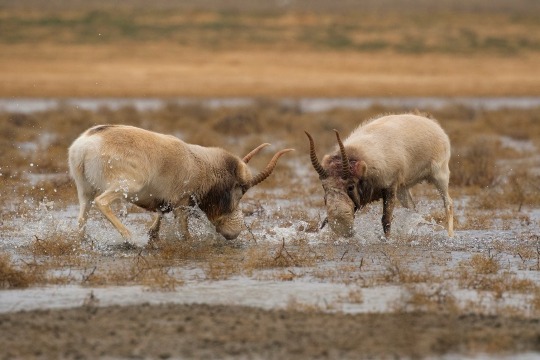
Male Saiga Antelope Battle in Black Lands National Park. Males and their horns are a specific target of poachers. Photograph By Valeriy Malee/Nature Picture Library
A Path to Recovery
Just as the threats to the saiga were multi-faceted, so too have been the efforts to protect the species, which are important seed dispersers and grazers that contribute to plant biodiversity.
For instance, an international collaboration between countries where saigas roam, countries that traditionally consume saiga products, and other stakeholder nations, including the United States, led to a memorandum of understanding in 2006 to conserve the species, restore its habitat, and restrict harvest to a sustainable level.
For its part, Kazakhstan’s government focused on stronger anti-poaching measures, including law enforcement to prevent saiga hunting. The Saiga Conservation Alliance supplied financing for gasoline, uniforms, motorbikes, and shelters for those rangers, who live in the harsh, windswept grasslands. Customs agents also improved detection of saiga products leaving the country as part of the illicit wildlife trade. Lastly, the country designated multiple protected areas totaling more than 12 million acres of saiga antelope habitat.
Now that economic conditions have leveled out and local people don’t have to choose between their own survival and saving saiga, there has also been a dramatic shift in support for the species.
“The thing about saiga is the local people really love it,” says Milner-Gulland. “It’s a symbol of the wild steppe, of independence and freedom.”
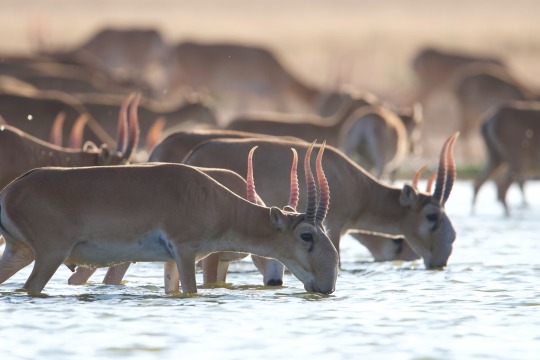
Saiga (Drinking on Southern Russia's Astrakhan Steppe) can migrate up to 600 miles over summer and winter. Photograph By Valeriy Malee/Nature Picture Library
#Animals 🦓 🦒 🐘#Floppy Nosed Antelope#Kazakhstan 🇰🇿 | Mongolia 🇲🇳 | Russia 🇷🇺 | Uzbekistan 🇺🇿#University of Oxford#Saiga Antelope#China 🇨🇳 | Singapore 🇸🇬 | Vietnam 🇻🇳 | Malaysia 🇲🇾#E.J. Milner-Gulland | Conservation Scientist | University of Oxford
36 notes
·
View notes
Text
Top 10 National Parks Of Thailand
Many feel the food in Chiang Mai to be the greatest in Thailand not really the world. Harbin has most varieties of entertainment and sporting buildings. It gradually infuses the leaves with the unique aroma of jasmine.
Safety Tips - Please keep yourself well hydrated, especially the particular summer months' time. At night walk around the camps with shoes on and use a flashlight concerning are plenty of scorpions and please maintain your vehicles when in the park!
View More: topphuthoaz.com - Top Phu Tho AZ
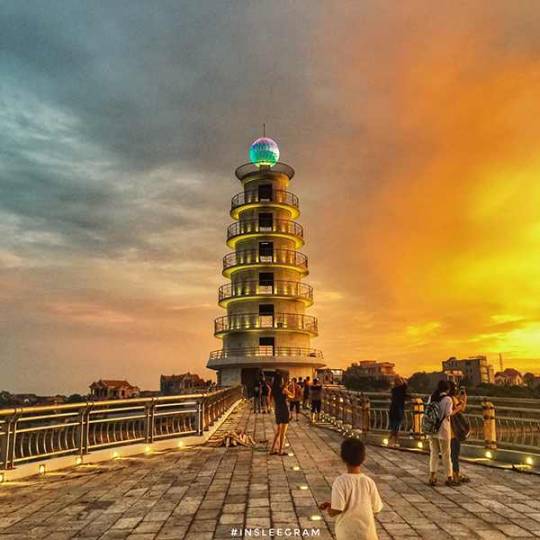
Reviewed by Team Leader in Top Phu Tho AZ: Ngô Thu Hường - Ngo Thu Huong
The average income in Harbin can be 1,000 RMB and cost of of living is fewer than other metropolitan areas. Therefore most people earning over 1,000 consider it to viewed as good paycheck. For food and basic shopping, a person can live comfortably on 1,000. However, most foreigners spend rather than that because they tend pay for more imported goods and eat oftener in restaurants including McDonalds, Pizza Hut and KFC. Therefore, if you want conserve money for travel or to send back home, must be able to save a quality portion of your salary, dependant how native you in order to live.
The park has associated with bird life, which includes many migrating birds plus Flamingos, ducks, herons and storks and ducks. You will find there's wide associated with reptiles, Italian wall lizards, Ocellated lizards, grass snakes and Latasters viper.

View More: topphuthoaz.com - Top Phu Tho AZ
Reviewed by Team Leader in Top Phu Tho AZ: Ngô Thu Hường - Ngo Thu Huong
At the north of the island of Ko Larn is the 7500 metre sweep of Hat Ta Waen Beach with its exotic white sand, lined with a string of stalls and shops. It is on Hat Ta Waen Beach that the sightseeing boats dock. They leave Pattaya South Pier every couple of hours. A day trip to the island of Ko Larn costs around $150.00. If it is beaches you have come towards the island for, there is the 700 metres stretch of Laem Thian Beach and the smaller Samae Beach, both situated round the south-west of the island. Both these beaches are designated places of natural beauty and tranquillity, with Laem Thian Beach particularly standing up for for its immaculately clean pristine and waters so clear it is simple to see the nearby coral industries. A hotel has now been built on Nuan Beach towards the southern tip of the island.
Amber Museum: Lots of tourist who come always pay a visit to the museum. It show cases a selection of of Amber which is specially Phu Tho Province rare every where. There are several variations of Ambers in numerous colors.
Lastly, certainly not forget to pay Palawan a call. The place options a wonderful biodiversity and is rich in natural resources. Palawan also boasts of their beaches and also beautiful underground caves. Visiting Palawan is bound to be any experience so it is nature at its best.
The park has plenty of bird life, which includes many migrating birds plus Flamingos, ducks, herons and storks and ducks. You'll find wide regarding reptiles, Italian wall lizards, Ocellated lizards, grass snakes and Latasters viper.
You've got the Great Wall practically next door, and the traditional capital Xian, another major tourist spot, in the neighboring province of Shaanxi. This may be the home of this Terra Cotta Warriors, and also can be aware of the whole saga of China's glorious past from the comfort of a bullet get trained.
The beaches have white fine sand also secluded coves with cliffs. It also contains fishing harbours and marinas, salt lagoons and nature stores. Top Phu Tho AZ 247 Vera has a water park with kamikaze, body ski, twisting slides, river adventure, black hole, large pool and lake and special children's pool and slides. A lot of produce is grown here such while like of Oranges and Grapes all covered with plastic. Of those ingredients exported to numerous of Europe.
The best position to start this run is in Kensington, at the 10th Saint. Bridge. Cross Memorial drive and proceed west along the riverbank to Crowchild trail. Cross the river and continue along when the bank get started the loop back. The scenery along this run is part of the most spectacular all of the city of Calgary. In order to choose this add up to be 10 Km you'll have to instigate a lap around Princes' Island Park before heading go back over the river and heading back for the Kensington passage. It should be noted that this in the end take you back into Kensington will probably end up right across from Crave Cupcakes. Damn you, Require. You win more.
youtube
Onto the north of the island of Ko Larn is the 7500 metre sweep of Hat Ta Waen Beach with its exotic white sand, lined with a string of stalls and online shops. It is on Hat Ta Waen Beach that the sightseeing boats dock. They leave Pattaya South Pier every two hours. A day trip to the island of Ko Larn costs around $150.00. Top Phu Tho AZ News If it is beaches you have come for the island for, there is the 700 metres stretch of Laem Thian Beach and the smaller Samae Beach, both situated by the south-west of the island. Tin Top Phú Thọ AZ 247 These two beaches are designated places of natural beauty and tranquillity, with Laem Thian Beach particularly standing out for its immaculately clean pristine and waters so clear it is simple to see the nearby coral industries. A hotel has now been built on Nuan Beach towards the southern tip belonging to the island.
Mat Mahathat has a sizeable seated Buddha as well as two standing Buddha. Wat Sri Chum typically the north zone has another enormous seated Buddha that's great to look at pictures associated with. If you can upward early enough to read the sun rise, you'll have the ability to witness the incredible effect the emerging sunlight has during the Buddha figurines Phu Tho Province . There are plenty of budget places to stay and eat and Sukhotai is with a small bus stop.
British Columbia offers a number of the most remarkable trout and Salmon fishing found just about anyplace. Fly anglers from on world congregate to this province aiming to land that river bound lunker. Would like to speak about panorama? Concerning embarking on a Canadian fishing vacation is actually situated within a scenic mountain region? Utilizing slow and fast moving waters the actual province the abundance of fish! This province will unquestionably test your fishing requirements. Fishing in BC is a you in no way forget!
Fuel rates are set by the fuel suppliers. No doubt many residents go online searching for lower price ranges. They go online searching for huge discounts. They see decent rates but often may well disappointed. If they live in Belfast, normally they is able to reduce their bills by only 2 to 5 Pounds every. There is little different between paying 450 Pounds from 445 Pounds per period of time.
The beaches have white fine sand also secluded coves with cliffs. What's more, it contains fishing harbours and marinas, salt lagoons and nature stocks. Vera has a water park with kamikaze, body ski, twisting slides, river adventure, black hole, large pool and lake and special children's pool and slideshow. A lot of produce is grown here such as the like of Oranges and Grapes all covered with plastic. Are generally generally exported to several of The european union.
If you're wanting expertise the wilderness of Nova Scotia, ensure that your way North to Cape Breton Island to feel the National Parks, lush hiking trails, a number of of finest kayaking found in the East sea-coast. Northern Nova Scotia is among the list of best places to luck out and kayak having a pod of whales. Cape Breton Island is just one of the best places to spend a weekend during summer time as well, there are countless campgrounds to try and whole family entertained. Most of which have some great beaches, running water and showers, along with playgrounds for him or her.
Needless to say home heating oil prices in Northern Ireland are perplexing and confusing. Neither the energy providers nor the media nor brand new has had time to satisfactory account for your exorbitant rates for heating oil fees. If the leading experts are not able to perplexed, the consumers forced shell out are confused. They just feel cheated and brought advantage within. Many of them do not know they will survive another cold snap this winter. Many of them do not know the way that they will stand financially after winter. Utilizing facing massive debt through middle within the summer. People can simply hope that prices will decrease by next morning. Can you say wishful thinking about?
Accommodation - There are three main camps (of which only Twee Rivieren and Mata Mata have air conditioning), one up-market lodge (!Xaus Lodge) and six wilderness camps, by using fully equipped kitchens and en-suite bathrooms in the chalets and cabins. Alternatives here . camping sites at nyc airports main camp. 'Twee Rivieren' is Dutch for 'Two Rivers' and, as historical past of the implies, the camping ground is situated at the confluence from the Nossob and Auob streams.
The muskie and northern pike are perhaps the two most aggressive freshwater fish in Canadian. They wait under structure and in standing weed beds waiting to assault unsuspecting prey as it swims by the. These ambushes frequently be responsible for a violent strike when a strong-willed fight you should be ready for. Every year pike around 30 pounds and muskie over 40 pounds are caught on freshwater fishing trips in Canada. Unpredicted expenses a battle you want - these fish are for they!
View More: topphuthoaz.com - Top Phu Tho AZ
Reviewed by Team Leader in Top Phu Tho AZ: Ngô Thu Hường - Ngo Thu Huong
Written By Author in topphuthoaz.com: Lê Hồng Đức - Le Hong Duc
Written By Author in topphuthoaz.com: La Thiên Vũ - La Thien Vu
0 notes
Text
Unveiling Earth's Ancient Chronicles: The Fascinating World of Paleontology

In the vast tapestry of Earth's history, each layer of sediment holds secrets waiting to be unearthed. Paleontology, the science of studying fossils, serves as a portal to the ancient past, unraveling the mysteries of life that once thrived on our planet. It is a discipline that bridges the gap between the distant past and our modern understanding of biology, geology, and evolution.
At its core, paleontology is a detective story, where clues are preserved in the form of fossils, providing snapshots of ancient ecosystems and the creatures that inhabited them. These fossils range from the microscopic to the colossal, from delicate impressions of leaves to the towering skeletons of dinosaurs. Through meticulous excavation and analysis, paleontologists piece together the evolutionary history of life on Earth, tracing the lineage of species and deciphering the processes that shaped biodiversity over millions of years.
One of the most iconic figures in paleontology is the dinosaur. These magnificent creatures ruled the Earth for over 160 million years before meeting their demise in the mass extinction event at the end of the Cretaceous period. From the ferocious Tyrannosaurus rex to the gentle giants like Brachiosaurus, dinosaurs captivate our imagination and offer insights into prehistoric ecosystems. Through fossilized bones, footprints, and even traces of soft tissues, scientists reconstruct the behavior, physiology, and ecology of these ancient reptiles.
However, paleontología extends far beyond dinosaurs. It encompasses the study of all forms of ancient life, from the microscopic organisms that flourished billions of years ago to the majestic megafauna of the Ice Age. Fossils provide evidence of evolutionary transitions, such as the gradual emergence of mammals following the extinction of dinosaurs or the adaptive radiation of birds from their dinosaurian ancestors.
Moreover, paleontology intersects with other fields of science, contributing to our understanding of Earth's geological history and the processes that have shaped its surface over time. By examining fossilized plants, pollen, and isotopic compositions, researchers reconstruct past climates and environments, shedding light on how Earth's ecosystems have responded to changes in temperature, atmospheric composition, and sea level throughout geological epochs.
Furthermore, paleontology plays a crucial role in conservation biology and paleoecology by providing baseline data for understanding modern biodiversity and predicting future ecological trends. By studying the fossil record, scientists identify patterns of extinction and speciation, informing efforts to preserve endangered species and ecosystems threatened by human activities.
In essence, paleontology is not just the study of ancient life; it is a journey through time that deepens our appreciation for the interconnectedness of life on Earth. By unraveling the stories preserved in rocks and fossils, paleontologists illuminate the path of evolution, offering glimpses of the past and guiding our stewardship of the planet for future generations. As we continue to explore Earth's geological archives, the fossils we uncover will undoubtedly reveal new chapters in the epic saga of life's evolution.
1 note
·
View note
Text
Sustainability Governance: Workshop and Summer School
I am part of a NSF funded Centers for Research and Innovation in Science, the Environment and Society (CRISES) planning grant and we are planning for a Center on Sustainability and Governance in the Anthropocene (C-SAGA) that focuses on innovative interdisciplinary social science research that develops and assesses needed new forms of environmental governance. This will require innovations across knowledge systems, attention to coproduction of solutions with multiple stakeholders who are empowered to act, and advances in understanding desirable visions of the future and how to achieve them. We have a launch symposium on May 7 that will feature three speakers addressing how to manage major challenges like climate change, food security, and biodiversity loss in the face of accelerating human pressure, increasing complexity, and persistent inequality. The day-long event will feature talks by Dr. Jennifer Clapp, Canada Research Chair & Professor, School of Environment, Resources and Sustainability, University of Waterloo, Canada; Dr. Ratana Chuenpagdee, Professor, Department of Geography, Memorial University of Newfoundland; and Dr. Meredith Gore, Associate Professor, Department of Geographical Sciences, University of Maryland College Park. We would welcome attendance in person or online and ask people to register here by May 1 to attend https://lnkd.in/eyXW8-Hi
We are also running an inaugural summer school for early career Ph.D. students working on governance and sustainability here at Rutgers August 20-23. The goal of the Summer School is to increase the capacity of early-stage researchers to learn more about this field and the need for interdisciplinary scholarship and collaboration. During the workshop, we will bring together scholars from a range of disciplines in a small group setting to learn, exchange ideas, and build partnerships. Training on essential skills will be offered on topics suited to the applicants, and may include working in collaborative governance, science communication, social science methods, and grant and publication guidance. Faculty from across Rutgers working in the sustainability governance area will opportunities for career advice, mentorship, and networking. At the end of the workshop, the relationships built with other students will provide mutual support for the future. Additional information can be found here: https://lnkd.in/e4qG6mN5 and applications are due May 15: https://lnkd.in/eRtGneVR
0 notes
Text

In the smoldering remnants of a forest scorched by the unforgiving inferno of war, stood Lieutenant Elara Solokov. Her uniform, though tattered, bore the marks of her valor—a fusion of historical insignia with the subtle integration of advanced technology indicative of the era she fought in. A holographic emblem of Eriopis connexa—her division's symbol, representing both resilience and their role in ecological warfare—gleamed on her shoulder.
The year was 2247, and Earth was embroiled in what would be known as the Green Wars, fought over the remaining sanctuaries of natural resources. Elara was a warrior of the Terran Coalition's BioGuard, an elite force specialized in protecting these havens using biologically engineered solutions.
The Coalition's enemy, the Syndicate, had deployed a genetically modified pathogen to obliterate the forest, Earth's last reservoir of untainted genetic biodiversity. Elara’s squad was equipped with Eriopis connexa, a bioengineered beetle with extraordinary capabilities, able to detoxify and restore the flora ravaged by the pathogen.
As the enemy advanced, Elara and her team released swarms of the beetles, which worked tirelessly, dismantling the deadly microorganisms at a molecular level. But the Syndicate wasn't done. They unleashed their latest weapon: nanodrones, designed to mimic and hunt Eriopis connexa.
Elara’s eyes, enhanced by cybernetic implants, scanned the horizon. She saw past the natural light spectrum, identifying the enemy drones camouflaged against the fiery backdrop. Raising her arm, she initiated a coded pulse from her wrist device. The beetles, in response, emitted a counter-frequency that disrupted the drones' sensors, creating an electronic symphony of war.
As the battle raged, it became more than a fight for territory—it was a testament to the resilience of life and the lengths to which humanity would go to preserve it. Elara, standing firm with her beetles turning the tide of destruction into one of rebirth, knew this was only the beginning. The forest, a phoenix rising from ashes, whispered of a future where war would give way to restoration.
This was Earth's last stand, and Lieutenant Elara Solokov, alongside her tiny winged allies, was ready to defend it until the skies were clear and the ground teemed with life once more. The saga of the BioGuard was etched into history, a chronicle of those who fought not just with guns and steel, but with the very essence of life itself.
1 note
·
View note
Text
A Tale of Two Crises: Climate Change and Julian Assange
In the modern world, two crises have captured global attention and stirred intense debate: the environmental catastrophe unfolding at the Great Barrier Reef due to climate change, and the legal battle faced by Julian Assange, the founder of WikiLeaks, fighting extradition to the United States. While seemingly disparate, these crises share underlying themes of secrecy, accountability, and the urgent need for action.
The Great Barrier Reef, often hailed as Australia's national treasure and a global wonder, is facing unprecedented threats from climate change-induced coral bleaching. Scientists, researchers, and environmentalists warn of the irreversible damage inflicted upon this fragile ecosystem, which supports a diverse array of marine life and plays a crucial role in the planet's ecosystem. The alarming statistics reveal a grim reality: over 50% of reef cover has disappeared since 1980, with projections indicating further declines in the coming decade. The urgency of addressing climate change and its impact on the Reef cannot be overstated, as its destruction carries profound implications for biodiversity, ecosystems, and coastal communities worldwide.
In parallel, the legal saga of Julian Assange highlights the complex interplay between transparency, freedom of the press, and government accountability. Assange's battle against extradition to the United States, where he faces espionage charges for publishing classified documents, has sparked intense debate over the limits of journalistic freedom and the rights of whistleblowers. While the legal intricacies of the case are significant, the broader implications for press freedom and government transparency are equally profound. Assange's plight underscores the importance of protecting those who expose truth and challenge authority, even in the face of powerful adversaries.
Despite their seemingly disparate nature, the crises of the Great Barrier Reef and Julian Assange share a common thread: the imperative to confront hidden truths and address systemic injustices. While Assange's case unfolds in courtrooms and legal arenas, the environmental crisis at the Great Barrier Reef unfolds in the natural world, where the consequences of inaction are equally dire. Both crises demand urgent attention and collective action, as they represent existential threats to the fabric of our society and the health of our planet.
In the final analysis, the real problem confronting humanity today is not just political or environmental—it is a crisis of secrecy, denial, and apathy in the face of overwhelming evidence. Climate change and government censorship are not isolated issues but interconnected manifestations of a deeper systemic failure to prioritize truth, accountability, and sustainability. To address these challenges, we must confront the uncomfortable truths they reveal and mobilize collective action to safeguard our planet and our freedoms for future generations.
#ClimateCrisis#EnvironmentalJustice#PressFreedom#Accountability#CollectiveAction#Urgency#Transparency#ClimateActionNow#SaveOurReef#FreeAssange#architecture#berlin#area#london#acme#chicago#puzzle#edwin lutyens#massimoscolari#oma
0 notes
Text
Embark on an Adventure with Sundarbanlokenathtravels!
Are you ready to experience the thrill of a lifetime? Look no further than Sundarbanlokenathtravels for the ultimate escapade into the heart of the Sundarbans! With us, your journey becomes an exhilarating saga of exploration, excitement, and unforgettable memories.

1. Discover the Magnificent Sundarbans Get ready to immerse yourself in the awe-inspiring beauty of the Sundarbans, a UNESCO World Heritage Site and the largest mangrove forest on the planet.
2. Unforgettable Wildlife Encounters Prepare to be amazed as you encounter the majestic Royal Bengal Tiger, playful dolphins, elusive crocodiles, sundarban trip and a myriad of bird species in their natural habitat.
3. Expertly Guided Tours Our experienced guides will lead you through the labyrinth of mangrove forests, sharing their knowledge and passion for the region's unique ecosystem.
4. Thrilling Boat Safaris Hop aboard our specially designed boats and cruise through the winding waterways of the Sundarbans, offering you an up-close view of its rich biodiversity.
5. Authentic Cultural Experiences Immerse yourself in the vibrant culture of the Sundarbans as you interact with local communities, learn about their traditions, and savor delicious regional cuisine.
6. Eco-Friendly Practices At Sundarbanlokenathtravels, we are committed to preserving the pristine beauty of the Sundarbans. Our eco-friendly practices ensure minimal impact on the environment, allowing future generations to enjoy its wonders.
7. Comfortable Accommodations Relax and unwind in our comfortable accommodations, strategically located to offer stunning views of the surrounding landscape while providing all the amenities you need for a memorable stay.
8. Sunrise and Sunset Spectacles Witness breathtaking sunrises and sunsets over the horizon, painting the sky with a mesmerizing array of colors, creating unforgettable moments that will stay with you forever.
9. Adventure-packed Excursions From thrilling jungle treks to exhilarating birdwatching expeditions, our adventure-packed excursions cater to every explorer's passion for discovery and excitement.
10. Photography Paradise Capture stunning shots of the Sundarbans' natural beauty, from its lush greenery to its diverse wildlife, and create lasting memories to cherish for years to come.
11. Safety First Your safety is our top priority. Rest assured, our expert team adheres to strict safety protocols to ensure a worry-free and enjoyable journey for all our guests.
12. Customize Your Experience Tailor your trip to suit your preferences with our customizable packages. Whether you're a wildlife enthusiast, a culture buff, or a photography aficionado, we have the perfect itinerary for you.
13. Educational Opportunities Gain valuable insights into the importance of conservation and sustainable tourism practices through our educational programs, designed to promote awareness and appreciation for the Sundarbans' ecological significance.
14. Family-Friendly Adventures Create unforgettable memories with your loved ones as you embark on a family-friendly adventure filled with laughter, learning, and bonding moments amidst nature's wonders.
15. Unparalleled Hospitality Experience the warmth and hospitality of the Sundarbans as our friendly staff caters to your every need, ensuring a comfortable and enjoyable experience from start to finish.
16. Nighttime Thrills Embark on thrilling nighttime excursions to catch a glimpse of the Sundarbans' nocturnal inhabitants, including owls, bats, and other fascinating creatures that come alive after dark.
17. Seasonal Highlights Each season in the Sundarbans offers its own unique charms. Whether you visit during the lush green monsoon, the cool winter months, or the vibrant spring season, you're guaranteed an unforgettable experience.
18. Conservation Efforts Support our ongoing conservation efforts aimed at protecting the Sundarbans' fragile ecosystem and preserving its biodiversity for future generations to enjoy.
19. Endless Adventure Awaits With endless opportunities for exploration and discovery, the Sundarbans promises an adventure of a lifetime that will leave you craving for more.
20. Book Your Trip Today! Don't miss out on the opportunity to embark on an extraordinary journey with Sundarbanlokenathtravels. Book your trip today and get ready to experience the magic of the Sundarbans like never before!
0 notes
Text
Unveiling Goa's Hidden Gems: A Traveler's Paradise Beyond the Obvious
Welcome, fellow explorers, to a journey off the beaten path in the tropical haven of Goa! While the sun-soaked beaches and vibrant nightlife are undoubtedly enchanting, there's a whole undiscovered world waiting for those willing to venture beyond the touristy hotspots.

Get ready for a unique odyssey as we uncover the best-hidden gems in Goa that will leave you awe-inspired.
1. Cotigao Wildlife Sanctuary - Nature's Symphony
Escape the crowds and delve into the heart of Goa's lush biodiversity at Cotigao Wildlife Sanctuary. A haven for wildlife enthusiasts, this sanctuary boasts dense forests, cascading waterfalls, and a chance to spot elusive creatures like the Indian giant squirrel. It's a perfect retreat for those seeking serenity and a touch of the wild.

2. Chorao Island - Birdwatcher's Paradise
For a tranquil escape, head to Chorao Island, Goa's best-kept secret. This idyllic island is a haven for birdwatchers, with the Dr. Salim Ali Bird Sanctuary offering a glimpse into the world of rare and migratory avian species. Take a boat ride through mangrove forests, and let the symphony of birds serenade your senses.

3. Netravali Wildlife Sanctuary - Hidden Water Wonders
Immerse yourself in the mystical beauty of Netravali Wildlife Sanctuary, where hidden waterfalls like Savari and Mainapi plunge into emerald-green pools. Trek through lush trails, encounter diverse flora and fauna, and rejuvenate your spirit in the lap of nature.

4. Divar Island - A Step Back in Time
Stepping back in time, Divar Island offers a glimpse into Goa's colonial past. Stroll through ancient churches, visit traditional Goan villages, and savor the unhurried pace of life. The charm lies in the narrow winding lanes and centuries-old architecture that whisper tales of a bygone era.

5. Arambol Sweet Water Lake - Oasis of Tranquility
Escape the bustling beach scene and discover the hidden gem of Arambol Sweet Water Lake. Tucked away amidst coconut groves, this serene lake is a peaceful retreat for those seeking quiet moments. Whether you're into yoga, birdwatching, or simply unwinding, this offbeat location is a slice of paradise.

6. Mhadei Wildlife Sanctuary - Trekking Extravaganza
Calling all adventure seekers! Mhadei Wildlife Sanctuary offers an exhilarating trekking experience amidst the Western Ghats. With diverse landscapes, cascading waterfalls, and panoramic views, this sanctuary promises an unforgettable journey for the intrepid traveler.

7. Tambdi Surla Temple - Ancient Marvel in the Jungle
Nestled in the heart of the jungle, Tambdi Surla Temple is a hidden architectural marvel. Dating back to the 12th century, this ancient temple dedicated to Lord Shiva exudes a mystical aura. The lush surroundings and intricate carvings make it a must-visit for history buffs and spiritual seekers.

Subscribe and Follow Adinaad the Explorer for More Hidden Gems!
Embark on a journey with Adinaad the Explorer, your guide to uncovering the hidden treasures of Goa. Subscribe for exclusive travel tips, offbeat destinations, and captivating tales of exploration. Follow Adinaad on social media to stay updated on the latest discoveries and join a community of like-minded adventurers.
Unleash the explorer within and make your Goa trip an unforgettable saga beyond the ordinary. Let the hidden wonders of this coastal paradise unveil themselves to you, one discovery at a time. Happy exploring!
#goa#best palces to visit goa#5 best places to vist goa#best places in india#photography#nature#best places to travel#best places to visit#adinaad the explorer#mountains#nature photography#wildlife#wildlife photography
0 notes
Text
Wings of Wonder: Birdwatcher's Chronicles in Nature

Introduction: Embarking on a journey into the realm of avian fascination, "Wings of Wonder" unfolds as a captivating saga, weaving the tales of dedicated birdwatchers who find solace, joy, and enlightenment in the enchanting world of birds. This blog delves into the essence of this extraordinary hobby, exploring the diverse experiences of birdwatchers as they chronicle their encounters with feathered wonders in the lap of nature.
The Call of the Wild: Birdwatching is a symphony of sights and sounds that beckons enthusiasts to venture into the great outdoors. With binoculars in hand and a heart full of curiosity, birdwatchers eagerly respond to the call of the wild. The Chronicles begin with the ethereal melody of birdsong, setting the stage for a profound connection between humans and the avian inhabitants of our natural landscapes.
Exploring Biodiversity: As these dedicated observers traverse diverse ecosystems, they unlock the treasure trove of biodiversity that birds bring to the tapestry of nature. From the vibrant hues of tropical parrots to the stealthy elegance of raptors, the Chronicles celebrate the myriad forms and colors that grace the skies. Each entry becomes a brushstroke in the living portrait of our planet's ecological richness.
In the Company of Feathers: "Wings of Wonder" unfolds as a collective narrative, as birdwatchers share their most cherished moments in the company of feathers. Whether witnessing the majestic dance of a courtship display or marveling at the intricacies of nest-building, these Chronicles capture the intimate details of avian life. Through the lens of a birdwatcher's gaze, even the common sparrow becomes a character in a captivating story.
Conservation through Observation: Beyond the sheer delight of spotting rare species, the Chronicles reflect a deeper purpose – conservation through observation. Birdwatchers play a crucial role in monitoring avian populations, documenting changes in migratory patterns, and advocating for the protection of crucial habitats. The passion for birdwatching transforms into a powerful force for environmental stewardship.
Challenges and Triumphs: The blog unfolds not just as a celebration of triumphs but also as an acknowledgment of challenges faced by birdwatchers. From adverse weather conditions to elusive species that test patience, the Chronicles resonate with the perseverance required to unravel the mysteries of the avian world. Each challenge met is a badge of honor, and every triumph a shared victory among the community of birdwatchers.
Conclusion: "Wings of Wonder: Birdwatcher's Chronicles in Nature" concludes as an ode to the pursuit of understanding and appreciating the delicate dance between birds and their habitats. These Chronicles serve as an invitation for both novices and seasoned birdwatchers to immerse themselves in the beauty of nature, fostering a deep connection that transcends the boundaries between humans and the enchanting creatures that grace our skies. As the sun sets on one birdwatcher's adventure, it rises on the next, ensuring that the Chronicles continue to unfold in perpetuity.
0 notes
Text
Adding To or Starting a Garden
AKA, the beginning of the Plants-Related section of this series.
This is my third post in a series I’ll be making on how to increase biodiversity on a budget! I’m not an expert--just an enthusiast--but I hope something you find here helps!
Got an area of lawn you’d like to convert to a wildlife haven? An area you can stick some hanging baskets in? Want to know how your garden of tomatoes and zucchinis is already putting in a lot of work? This is the section for you!
It would be dumb of me to not acknowledge that the act of gardening can come with a lot of costs. Buying seeds, buying plants, buying soil, raised bed materials, mulch, etc. … it can all get a bit daunting, let’s be honest! But there’s quite a few ways to get seeds and plants for free or extremely cheap, which I’ll be addressing in this section! The next section will be all about addressing the other Costs in gardening and how to mitigate or eliminate them entirely.
Also, do keep in mind; there’s no need to try and convert a whole area from lawn to garden or unused to garden at once. In fact, it could actually be extremely beneficial to do it a little at a time--maybe four or five square feet to start out.
Front Lawn (or Managing Principles)
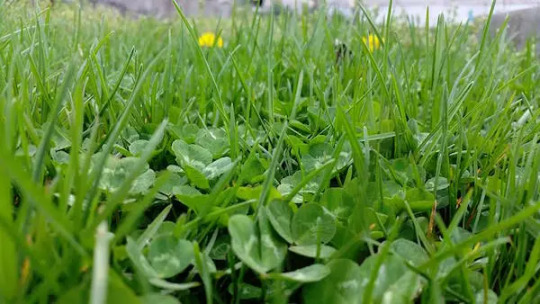
If you live in a place where you’re required to have a grass turf lawn (HOA’s come to mind…), try replacing it with native grasses instead! You could even possibly use a low-growing ground cover plant like clover to a similar effect! Reseeding/replacing an entire lawn can be a big upfront cost, but even just letting the lawn be a little messy and tall helps. If the lawn gets patchy, leave the bare spots for a little while and something different will likely pop up! Pioneer species will fill the gaps and provide benefits to other plants around them, support animals, and more! If you want to take the guesswork out of it, you could always research what the pioneer species are in your area and plant the ones you like most.
Obtaining Seeds for Cheap or Free
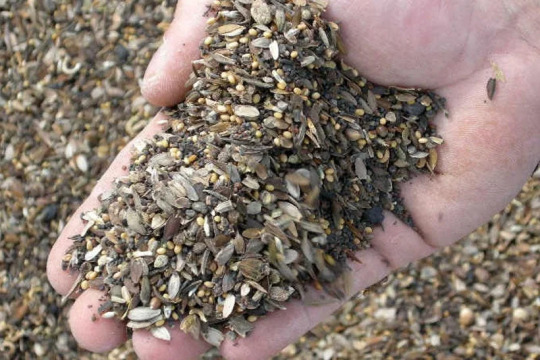
The cheapest way to start a garden is by far via seeds. However, seeds can be a bit complicated to grow, and some sources make them… way overpriced. Fortunately there are ways to get seeds for little to no cost!
Some places sell seeds for as low as a dollar, 50 cents, or 25 cents! The packets may not have a lot of seeds, but it’s definitely a good start for a low budget! I’ve personally bought cheap seed packets at Walmart--the Ferry-Morse and Burpee brands are not what we’re looking for here. Typically the cheaper ones I’ve found are American Seed (which is owned by Green Garden Products, which also owns Ferry-Morse, Livingston Seed, McKenzie Seed, and Seeds of Change. Do with that information what you will), but they’re rarely stocked near the Ferry-Morse ones in the Formal Gardening Section. I’ve most often found them on end caps near the gardening section, so you may have to weave through a few aisles to find them, but once you do there’s an array of flower and vegetable seeds to select from! Alternatively, I’ve found seeds at Dollar Tree sold 2 or 4 for a dollar in Spring as part of their seasonal product; however, when they’re out of stock, they’re typically out of stock for the year. Try to check them out early in the year!

Otherwise, other seed companies like Urban Farmer or Botanical Interests will often have semi-frequent sales in spring and fall, when people are stocking up on seeds--joining their email lists can help you be the first to know when a good sale is going on!
Some foods from grocery stores will provide seeds that you can use in the garden as well. I’ve had the most luck with store-bought bagged beans, peppers, and tomatoes. Some people have had luck with watermelons, apples, citrus, squash, and more. Do keep in mind that you likely won’t get the same variety of fruit/vegetable as the one you bought--the resulting plant may look different and taste different.

Give it a shot! Pick some beans you like--if they don't grow well, at least you can eat the rest!
If you live in the US, food-producing live plants, bare roots, and seeds can often be purchased with SNAP benefits. But what does growing fruits, veggies, and herbs have to do with boosting biodiversity? While food crops aren’t typically native, they still provide valuable shelter for native insects. Some plants even have intricate relationships with native fauna--like the squash bee, a solitary bee which exclusively pollinates cucurbits like pumpkins, squash, and zucchini. And we get to benefit more directly as well! If you’re planting a diverse range of foods in your garden (as opposed to the swaths of single-plant farms that typically produce what’s sent to grocery stores), you’re supporting high levels of biodiversity by providing a variety of plants for creatures to live and hunt around.
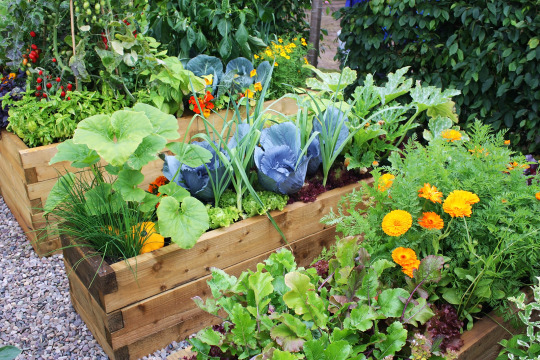
Most of the time, when we think of boosting biodiversity with a garden, we think of a colorful flower garden teeming with pollinator species. However, if we’re striving to use native species, it can be a bit difficult to find some species in stores. I can say from experience that trying to find any wildflower seeds other than butterfly weed, purple coneflowers, and black-eyed-susans is… challenging, if you limit yourself to stores like Walmart, Home Depot, and Lowe’s. You might occasionally get lucky with an ACE Hardware or a local nursery, but even then sometimes it can be hard to track down who in your area is selling what--let alone if you live in an area where no one really is selling native plants or their seeds. Not to mention, even once you find a local or online store selling the seeds you want, they can sometimes cost a pretty penny. So what do you do?
If you have the option to, consider gathering native seeds yourself! Get good at identifying the native flora and fauna--or at least, a few target plants and their lookalikes--and get ready to go! Learn where they tend to grow, when they’ll be seeding, etc. Try to identify the plant before it goes to seed (for most plants, it's easiest to identify when flowering), then check back regularly to gather seeds. Typically, if I want to learn how to collect seed from a specific plant, I just search it on Google or YouTube--oftentimes, I'm lead to the GrowItBuildIt Youtube page, so it may be a helpful resource for you as well! Of course, make sure to leave plenty of seed behind so the wild population can repopulate, and seed can feed other creatures in the area. A good rule of thumb is to take no more than 1/3rd of what's available.

Buying seed in bulk is an option if you can afford the upfront cost. Try teaming up with a few friends to buy some bulk seeds and split them amongst yourselves--you’ll get tons of seed! Prairie Moon is a popular site that'll sell seeds by the pound if you can afford the price--though they're in the US, and I believe they focus on Midwest and East Coast natives.
If you want to cheat the system, don’t buy bulk sunflower seeds--buy bags of sunflower seeds being sold as birdseed. They’re typically all black oil sunflower seeds, but they’ll sprout, and they’re fairly cheap for the amount you get!
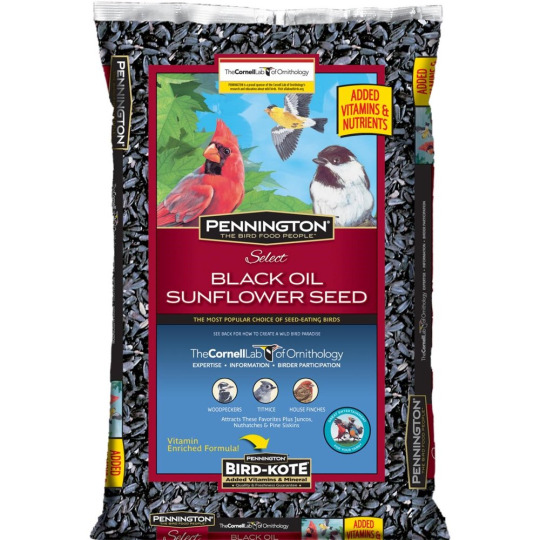
However, beware generic wildflower seed mixes! Many brands like to sell wildflower seed mixes in big box stores like Home Depot, Target, or even Dollar Tree, but they’ll often include flowers that aren’t native or possibly even invasive in your region! Before you make any purchases, double check to make sure the contained seeds won’t do more harm than good! A quality source of native seeds will provide English and Latin names for all seeds included, and will be native to the region or at least non-invasive.

See this? I don't trust this.
There’s a good handful of programs online that’ll send you free seeds if you’re planning to start a native habitat project! Poke around online and see what you can find; you might get lucky! The best time to start looking for these is fall and winter, I find--by early spring, many of them are either done or beginning to wind down... though some also start up in spring. Ultimately--just check regularly! You never know what you can find!
Other Ways to Get Plants
Don’t want to start from seed? That’s fair! You can try cuttings! Just be sure not to take too much of the plant while you do so. Make sure you’ve gotten a few leaf nodes on your cutting, and cut any flowers you may have gotten. Make sure to leave some blooms and foliage on the original plant for the creatures in the current habitat--you don’t want to destroy one habitat to make another in your garden. There’s tons of methods of rooting cuttings, many of which have different efficacy rates for different plants, but that’s a topic for another post.
If you find seedlings growing in a place where they won’t be able to sustain themselves long-term, or are in danger of being destroyed, consider relocating them! You may be able to gently dig up and transplant the seedling to your garden. Don’t do this if they’re in a place where they can easily survive--ideally, you’ll be taking plants from sidewalk cracks, heavily maintained public gardens, roadsides, etc. Do be careful while doing this--ensure your safety first!

You’re totally allowed to join gardening communities like clubs, facebook groups, and more before you’ve even put a trowel to the dirt. These are great places to learn information and advice! Many gardeners are more than happy to help out a new gardener, and will eagerly provide seeds, cuttings, or even baby plants! Talk to some people about your gardening journey and what you’re hoping to do, and you just might find some kindred spirits--or at least get more people interested in the topic!
Seed and plant giveaways and trades happen all the time in gardening clubs, as well as online! Just poke around and see what you can find! Some are explicitly trades, meaning you’re expected to send something in return, but once you get your feet on the ground with some plant knowledge you’ll be stellar! You may be able to explain you’re just starting out, and someone may send you seeds without expecting a trade, but I’d suggest trying giveaways first.

Poke around online and see if there’s a local chapter of your state’s native plant society. From there, you’ll likely be able to find a calendar of events--many of them will host plant sales in the spring, with a bunch of native plant seedlings ripe for the pickings if you can make it out and have some money to spare! Fair warning, though, you’ll want to get there early if you can. If they say they’re starting at 10, try to get there by 9:45. Year after year, there’s always record turnout, and they sell out of plants faster than ever. Just trust me on this. I’ve been let down; hopefully you won’t have to be.
Some libraries are beginning to host seed libraries! Check around and see if your library has one! Ideally, the system works best if you also have seeds to contribute in return, but if you’re just starting out I’m sure they won’t mind you taking some seeds! Just consider saving some seeds to contribute in the future and pay it forward. If your library doesn’t have a seed library? Consider asking if they’d be willing to start one! Community interest is a great way to get the ball rolling on projects like these, but they’ll only know the community is interested if the community tells them they’re interested!
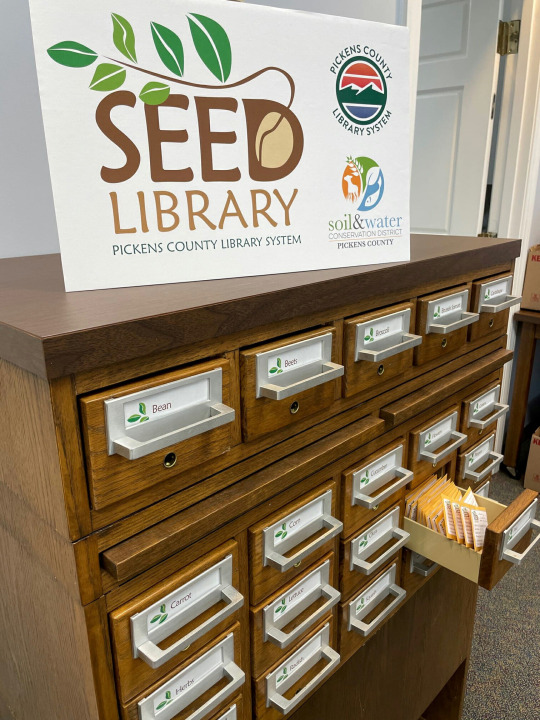
Volunteer to Garden for/with Someone Else
Maybe someone in your area wants to garden, but is struggling to find the time/energy. Many elderly people who used to garden simply can’t anymore but still would like a garden. Other people may love to have a helping hand in their garden. You might even find a few people in your area interested in renting and sharing a community garden plot with others, so they don't have to handle it all on their own! They may be interested in increasing biodiversity right now, or may be willing to if it’s brought up to them. You might be just the kind of person someone needs! Since it won't be your garden, you’ll likely need a bit of permission and collaboration to get anything in particular going, but it’s worth a shot and a way to maybe even make friends!
Again, your mileage may vary with some of these. You may not know where there's a bunch of wildflowers growing in your area, or maybe your local library doesn't have a free seed library. That's okay! Do what you're able to, find what you can find, get what you can get! And there's never any shame with starting small--in fact, starting small can make the project easier to manage and expand when you're able!
That's the end of this post! My next post is gonna be about ways to start growing plants cheaply--low cost seed starting set ups, essentially. There's a lot of good options, many of which I've used myself even! Until then, I hope this advice is helpful! Feel free to reply with any questions, success stories, or anything you think I may have forgotten to add in!
#biodiversity#solarpunk#gardening#outdoor gardening#growing from seed#ani rambles#out of queue#the biodiversity saga#i will be honest I have never flat out approached people to offer to help them garden#HOWEVER. People HAVE approached ME asking ME to help THEM with/plan THEIR garden#granted it was after I'd been gardening for a good few years. and its mostly family or family friends but yknow#people would be like 'oh wanna help me with my veggie garden?' even before I tried growing vegetables#i don't think the library near me has a seed library but you just wait until i. get the courage. to go to the library regularly.#i've seen people also make their own little seed library structures kinda like a little free library but like#i dont think my neighborhood is about that life.#if any of yall have those though it could be a great resource! also send pics because I love seeing them#not to say that this post should become a giant seed trade but if it did become that i would be the opposite of mad#if there's any typos blame my sister shes got the hotel room at like 60-something degrees and I am FREEZING#welp time to shut up now bye
1K notes
·
View notes
Text
Exploring The Evolutionary Marvels At the Natural History Museum In London
Embark on an awe-inspiring odyssey through time at the Natural History Museum in London, where the marvels of evolution come alive. Delve into the origins of life, wander among prehistoric giants like the mighty T-Rex, and trace humanity's evolutionary journey. Engage with interactive exhibits illustrating adaptation, biodiversity, and the intricate dance of life forms. Unveil the mysteries of extinction and conservation efforts, unraveling the captivating story of evolution that shapes our understanding of life's incredible diversity.

Introduction to Evolutionary Marvels
Enter the captivating realm of evolutionary marvels at London's Natural History Museum. This introductory glimpse into evolution unfolds the profound significance of life's transformational journey. From the emergence of life on a primordial Earth to the diversity of species today, explore the museum's exhibitions that illuminate the mechanisms of adaptation, extinction, and the breathtaking saga of evolution that defines our world's astonishing biodiversity.
Evolutionary Ecology and Biodiversity
Evolutionary ecology and biodiversity reveal nature's intricate dance. At the Natural History Museum, explore how ecosystems evolve and sustain life's diversity. Discover the interplay between organisms and environments, showcasing nature's resilience and adaptation. Dive into exhibits unraveling the complex web of life, showcasing the breathtaking variety of species and their evolutionary adaptations across diverse habitats, shaping Earth's biodiversity.
Future Perspectives in Evolutionary Studies
Future perspectives in evolutionary studies at the Natural History Museum herald an exciting era of exploration. Advancements in genetics, environmental sciences, and technology open new vistas, promising deeper insights into evolutionary processes. Emerging research directions, from molecular evolution to ecological modeling, pave the way for unraveling more of nature's enigmatic evolutionary tapestry.
Extinction and Conservation
At the Natural History Museum, examine the somber narrative of extinction and the hopeful saga of conservation efforts. Exhibits highlight lessons from past extinction events, emphasizing the urgency of preserving biodiversity. Discover ongoing conservation initiatives, underscoring the museum's commitment to safeguarding Earth's ecosystems, advocating for sustainable practices, and inspiring action for a more biodiverse future.
0 notes
Text
33+ Fascinating Advanced Higher Biology Project Ideas for Avid Learners

Are you an Advanced Higher Biology student yearning for a meaningful project that not only deepens your understanding but also sets your passion for biology ablaze? You're in the right place! In this blog, we'll take a deep dive into more than 33+ advanced biology project ideas that will transform your journey into an exciting and intellectually rewarding experience.
Genetic Disorders Exploration:
Uncover the intricacies of a specific genetic disorder, unraveling its origins, symptoms, and prospective treatment avenues.
Cancer Biology Investigation:
Venture into the multifaceted realm of cancer biology, probing into the underlying mechanisms and potential therapeutic approaches.
Comparative Anatomy Adventure:
Embark on a journey of comparative anatomy, scrutinizing the anatomical structures of different animal species to unveil their evolutionary connections.
Microbial Marvels:
Dive into the mysterious microbial world as you explore the diversity of microorganisms inhabiting a chosen environment.
Ecological Surveys and Biodiversity Assessment:
Conduct in-depth field surveys to assess the biodiversity and environmental impact of a specific area, potentially identifying ways to protect it.
DNA Fingerprinting Unveiled:
Master the art of DNA fingerprinting and delve into its applications in forensic science.
Human Physiology Deconstructed:
Take a comprehensive journey through the human body, unraveling the intricacies of its various systems and their functions.
Biodiversity Hotspots Expedition:
Investigate a local biodiversity hotspot, focusing on unique species, and contribute to their preservation.
Insect Behavior Observatory:
Immerse yourself in the fascinating world of insects, scrutinizing their behavior, interactions, and ecological roles.
Phylogenetic Tree Construction:
Construct a visual representation of evolutionary relationships among various species, offering insights into the tree of life.
Plant Genetics and Agriculture:
Delve into the world of plant genetics, exploring gene expression and its applications in agriculture and crop improvement.
Endangered Species Conservation Crusade:
Research and advocate for the conservation efforts directed towards safeguarding endangered species and their habitats.
Marine Biology Odyssey:
Dive into the depths of marine ecosystems, discovering the enchanting world of marine life and the challenges it faces.
Animal Behavior Analysis and Communication:
Delve into the captivating world of animal behavior and communication, deciphering their intricate languages.
Immunology and Vaccination Unraveled:
Explore the complex workings of the immune system and the science behind the development of life-saving vaccines.
Molecular Biology Techniques Mastery:
Hone your skills in pivotal molecular biology techniques like PCR, gel electrophoresis, and DNA sequencing.
Neuroscience Exploration:
Plunge into the intricacies of the human brain, investigating its functions and unraveling the mysteries of the mind.
Climate Change's Impact on Ecosystems:
Analyze the profound impact of climate change on diverse ecosystems and their inhabitants, helping raise awareness and inspire change.
Hormonal Regulation and Physiological Balance:
Investigate the role of hormones in maintaining physiological equilibrium and their significance in health and disease.
Cell Signaling Pathways Demystified:
Untangle the intricate web of cellular signaling pathways, understanding their essential role in coordinating cellular activities.
Zoology and Taxonomy Journey:
Embark on an exciting exploration of zoology and taxonomy, unraveling the classification and characteristics of animal species.
Genetically Modified Organisms (GMOs) Saga:
Dive into the GMO debate, dissecting the science behind genetically modified organisms and their impact on agriculture and society.
Biomedical Ethics Expedition:
Tackle complex ethical dilemmas in biomedical research, offering thoughtful insights into the moral compass guiding scientific progress.
Microbiome Mysteries Unveiled:
Unearth the secrets of the human microbiome, exploring its crucial role in health and disease.
Invasive Species Impact Assessment:
Investigate the disruptive impact of invasive species on native ecosystems, presenting strategies for mitigation.
Bioinformatics and Computational Biology Odyssey:
Bridge the gap between biology and computer science, uncovering the pivotal role of computational tools in advancing biological research.
Stem Cell Revolution:
Explore the potential applications and ethical considerations surrounding stem cell research, an area teeming with promise.
Epigenetics and Generational Inheritance:
Delve into the intriguing world of epigenetics and its role in the transmission of traits across generations.
Human Genetic Diversity Exploration:
Embark on a genetic journey, scrutinizing the diversity of human populations and understanding the factors shaping our genetic landscape.
Bioluminescence: Nature's Light Show:
Illuminate the fascinating world of organisms that emit light, exploring the biological mechanisms behind this captivating phenomenon.
Aquaponics Systems: Sustainable Agriculture in Action:
Design and implement an aquaponics system to gain insights into sustainable agriculture practices and the intricate balance of aquatic and plant life.
Biochemistry of Photosynthesis Unveiled:
Dissect the biochemical intricacies of photosynthesis in plants, unraveling the process that powers the plant world.
Bridging Biology and Art:
Marry art and biology to create visually stunning representations of scientific concepts, captivating both scientists and art enthusiasts.
Pharmacology and Drug Development Odyssey:
Journey through the complex process of drug development, from initial discovery to clinical applications, understanding the vital role of pharmacology in healthcare.
Cellular Respiration and Energy Production Expedition:
Journey into the heart of cellular respiration, exploring the intricate processes that generate energy to power life.
Ecosystem Services Investigation:
Uncover the hidden services ecosystems provide to humanity, underscoring the importance of preserving these vital natural systems.
Biology in the Cosmos:
Ponder the challenges and prospects of conducting biological research in space, shedding light on the exciting future of space exploration and biology.
Ornithology and Avian Migration Expedition:
Delve into the avian realm, exploring the wonders of bird species and their fascinating migratory patterns.
Nutrition and Health Nexus:
Investigate the intricate link between nutrition and human health, uncovering the secrets to a healthy, well-balanced life.
With this treasure trove of project ideas, you're now equipped to embark on an incredible journey through the realm of Advanced Higher Biology. Not only will you bolster your knowledge and analytical skills, but you'll also kindle a fervent passion for the intricate tapestry of life on our planet. So, pick a project that resonates with your curiosity and embark on a biology adventure that will redefine your academic experience. Happy researching!
0 notes
Text
St. Louis Uncovered_ Beyond the Gateway Arch — Patricia _Patty_ Wente
St. Louis, often recognized by its famous Gateway Arch, is a city rich in American history and distinctive culture. Established in 1764, the city was a key trading post in the westward expansion of the United States. Over the centuries, St. Louis has grown into a vibrant metropolis, boasting a unique blend of Southern charm and Midwestern hospitality.
Standing at a towering 630 feet, the Gateway Arch serves as a testament to the city’s historical significance as the “Gateway to the West”. Designed by architect Eero Saarinen and completed in 1965, the stainless steel monument is the world’s tallest arch and a symbol of the city’s enduring spirit. Visitors can take a tram ride to the top of the arch, which offers a bird’s-eye view of the city’s landscape — a captivating sight that truly underscores the vastness and beauty of St. Louis.
One of the largest urban parks in the United States, Forest Park is a veritable oasis in the heart of St. Louis. Spread over 1,300 acres, the park is home to a variety of amenities, including the St. Louis Zoo, the St. Louis Art Museum, and the St. Louis Science Center. The park’s verdant landscapes also offer a multitude of recreational opportunities, from scenic walking and biking trails to waterways for paddle boating. Patricia Wente Articles
The Missouri Botanical Garden, affectionately known as ‘Shaw’s Garden’ after its founder Henry Shaw, is a haven of biodiversity. Housing one of the world’s largest collections of rare and endangered orchids, the garden offers a mesmerizing array of botanical wonders. The Climatron, a geodesic dome conservatory, replicates a lowland rainforest ecosystem, making it a must-visit for nature enthusiasts.
Owned by the Busch family, the founders of the Anheuser-Busch Brewery, Grant’s Farm is an exciting destination that combines history, heritage, and wildlife. The 281-acre farm, which was once home to Ulysses S. Grant, the 18th President of the United States, is now a vibrant wildlife preserve, housing over 900 animals from more than 100 species. Visitors can take a tram tour of the park to spot buffalo, deer, zebras, and more, making it an unforgettable experience for the entire family.
Renowned for its unique composition, the City Museum of St. Louis is a sublime marriage of a children’s playground and a surrealistic pavilion. Housed in the former International Shoe building, the museum is an eclectic mixture of architectural marvels, constructed from repurposed urban materials. With a vast network of tunnels, slides, and secret passages, it invites visitors of all ages into its fantastical world of exploration and discovery.
Perched atop Art Hill in Forest Park, the St. Louis Art Museum is one of the leading comprehensive art museums in the country. Its extensive collection spans over 5,000 years of history, encompassing works from virtually every culture and period. From exceptional Egyptian antiquities to innovative contemporary art, the museum offers an enriching journey through the annals of artistic expression. Its grand Beaux-Arts architecture and serene setting further add to its timeless allure. Patty Wente
Steeped in history, the Old Courthouse holds an indelible place in American civil rights history. It was here, in 1846 and 1850, that the landmark Dred Scott cases were heard, propelling the nation towards the Civil War and ultimately leading to the abolition of slavery. The building, a stunning example of Greek Revival architecture, now serves as a museum, recounting the saga of St. Louis’s past and the pivotal role it played in the nation’s struggle for equality.
St. Louis takes barbecue very seriously, and the city’s take on this culinary tradition is unique in its own right. St. Louis-style barbecue is characterized by the specific cut of ribs, known as St. Louis-style ribs, where the sternum bone, cartilage, and rib tips are removed to create a rectangular-shaped rack. These ribs are then typically slow-cooked using a grill, and slathered with a rich, tangy, tomato-based sauce that perfectly complements the smoky flavour of the meat. The city’s numerous barbecue joints offer a feast to the senses, serving up platters laden with succulent ribs, pulled pork, and other smoked delights.
For a taste of the city’s fresh produce, visit some of St. Louis’s bustling farmers’ markets. The historic Soulard Market, operating since 1779, is a local favourite and one of the oldest public markets in the U.S. From vibrant fresh fruits, and vegetables, to artisan cheeses and fresh baked goods, the market offers a cornucopia of local produce. Tower Grove Farmers’ Market, set in the scenic Tower Grove Park, is another fantastic destination to explore the city’s farm-to-table offerings. These markets not only provide a taste of the region’s bountiful harvest but also support local farmers and foster community spirit.
No culinary journey in St. Louis would be complete without a visit to the Anheuser-Busch Brewery. This historic brewery, opened in 1852, is not just the birthplace of the world-famous Budweiser beer — it’s a symbol of the city’s brewing legacy. Visitors can take a guided tour of the brewery to learn about the rich history of this brewing giant, witness the brewing process up close, and even meet the iconic Budweiser Clydesdale horses. Round off the experience with a beer-tasting session, where you can sample some of Anheuser-Busch’s classic brews as well as their latest offerings.
St. Louis has a rich jazz and blues heritage, with its sound deeply rooted in its cultural and historical fabric. The city was at the forefront of the blues movement in the early 20th century, and it continues to be a thriving hub for this soulful genre. Renowned blues artists hail from St. Louis, playing in numerous clubs across the city and at the annual Big Muddy Blues Festival. Similarly, the jazz scene is vibrant and dynamic, with local musicians keeping the tradition alive through innovative compositions that honour the past while looking toward the future. Jazz and blues enthusiasts can soak in the city’s musical spirit at various venues, festivals, and jam sessions.
In the heart of St. Louis’s music scene are two renowned venues: The Pageant and Blueberry Hill. The Pageant, regarded as one of the top concert venues in the country, hosts a diverse array of artists and bands, from up-and-coming talent to established international acts. Its intimate setting ensures a unique concert experience, where every seat is “the best seat in the house”. Just a stone’s throw away is Blueberry Hill, a landmark music club and restaurant in The Loop neighbourhood. Known for its vibrant ambience and historical significance, Blueberry Hill is synonymous with music legend Chuck Berry, who performed there over 200 times. Its famed Duck Room continues to host national touring bands and local musicians, making it a must-visit for music lovers exploring St. Louis’s nightlife.
In essence, St. Louis is a city of diverse experiences, each one adding a unique layer to its cultural mosaic. It’s a city that invites exploration, promising a journey of discovery that extends far beyond the shadow of the Gateway Arch. St. Louis is not just a city — it’s a vibrant tapestry of history, art, cuisine, music, and so much more.
0 notes
Text
Defenders of the Jordanian Highlands: Ajloun's Account
In the upper reaches of Jordan, situated among running hills and ancient olive groves, lies the area of Ajloun. A mosaic of history and character, Ajloun stands as a testament to the resilience and varied history of the land.
A Fortress Against Time
Owning the landscape and the history of Ajloun is the Ajloun Castle, locally known as Qa'lat Ar-Rabad. Integrated the 12th century by certainly one of Salah ad-Din's generals, that Islamic fortress was initially established to fend down Crusader incursions. Having its solid walls, towers, and proper place overlooking the Jordan Pit, the fortress performed a vital role in a variety of historical events. Over the years, it has seen improvements and reconstructions, showing the changing tides of history. Nowadays, it stands not only as a military relic, but as a image of the strength and modern material of the region. حكاية عجلون
Nature's Sanctuary
But Ajloun is not only about man-made marvels. The Ajloun Forest Arrange, a verdant expanse covering around 13 square kilometers, displays the region's ecological significance. Home to an abundant biodiversity, the arrange shelters creatures such as the striped hyena, rock marten, and different species of birds. The thick woods of walnut, pine, and crazy pistachio are a stimulating sight in a nation usually known for their leave landscapes.
Beyond keeping its ecology, the arrange also empowers regional communities. The local Bedouin tribes have performed an intrinsic position in the conservation attempts, turning from woodcutters to custodians of the forest. Initiatives here have promoted sustainable tourism, providing trekking, homestays, and real Jordanian experiences.
Lifestyle Amidst the Groves
Number story of Ajloun is total without mentioning its centuries-old olive groves. Olive growth is a built-in section of Ajloun's ethnic and economic identity. The cold winters and long summers give Ajloun olives a unique taste, making the region's coconut oil extremely wanted after. Annual olive festivals observe this bond, blending commerce, lifestyle, and neighborhood in a good gathering.
A Symbol of Coexistence
Perhaps the most outstanding aspect of Ajloun is their embodiment of coexistence. Here, Religious and Muslim communities have existed alongside for centuries. The city of Anjara, regarded among the biblical towns of refuge, is really a significant pilgrimage site for Christians and features the shrine of Our Woman of the Mountain.
Realization
Ajloun, in their silent beauty, narrates a story that weaves the stories of ancient warriors, devout believers, and nature's guardians. Within an ever-globalizing earth, it remains a bastion of history, ecology, and culture, advocating visitors to stop, reflect, and immerse themselves in its timeless saga.
0 notes
Text
Thursday, March 18, 2021
Battling bigness: Congress eyes action against monopolies
(AP) The battle against bigness is building. Whether it’s beer, banks or book publishing, lawmakers are targeting major industries they say have become so concentrated that they’re hurting competition, consumers and the economy. The economic dislocation of the pandemic has laid bare the struggles of small businesses unable to compete with corporate giants that have been able to capitalize on the new order. Experts and lawmakers are throwing out stunning stats: The four biggest airlines control about 65% of U.S. passenger traffic, five giant healthcare insurers control an estimated 45% of the market, pharmaceuticals are dominated by three major companies, the top four banks control about 44% of the market, the so-called Big Five book publishers control some 80% of the U.S. book market, and Google alone accounts for about 90% of web searches worldwide. Beer and a burger? Four companies are estimated to control 80% of U.S. meat-packing; the top four brewers and importers control about 76% of the U.S. beer market. Critics say the corporate concentration is quickening, limiting consumers’ choices, raising prices and eroding service.
Bloodshed in Atlanta
(Reuters) Eight people, six of them women of Asian descent, were shot dead in a string of attacks on Atlanta-area day spas on Tuesday, and a man suspected of carrying out all of the shootings was arrested hours later in southern Georgia. The violence unfolded days after U.S. President Joe Biden used a nationally televised speech to condemn a recent surge in hate crimes and discrimination against Asian-Americans.
On Mexico’s Border With U.S., Desperation as Migrant Traffic Piles Up
(NYT) The migrants’ hopes have been drummed up by human smugglers who promise that President Biden’s administration will welcome them. Instead, the United States is expelling them back to Mexico, where they wait along with tens of thousands of others hoping to cross. The pressure, and desperation, is quickly building among families stuck in Mexico, as shelters and officials struggle to help them. Shelters that were empty four months ago are now having to turn many away.
Chinese fishing fleets are sweeping South American oceans dry
(Clarin/Argentina) A new Greenpeace report warns that foreign fishing fleets, mostly from China, are gobbling up every bit of marine life they can into “stadium-sized” nets in Argentina’s sea waters, writes Natasha Niebieskikwiat in Buenos Aires-based daily Clarin. The environmental group Greenpeace recently counted at least 470 boats in a biodiversity hotspot known as “Agujero Azul” or the “Blue Hole,” off the Patagonian coast between Chubut and Santa Cruz. Luisina Vueso, who worked on the report, told Clarín that usually, Argentine coastal waters have 270 boats concentrated in an area of roughly 1 million square kilometers. Right now there are 470 boats extracting stock like squid and other species in barely 5,000 square kilometers. Greenpeace warns that there are no checks on this type of fishing, which sweeps up marine life with underwater nets almost the size of football pitches. These reach the seabed and pick up all there is, regardless of numbers, endangered status or usefulness. Greenpeace concluded in 2019 that years of exploitation had devastated the seabed off the Argentine coast.
Boris Johnson’s vision for post-Brexit ‘Global Britain’ includes more nuclear weapons
(NYT) In a declaration of its aspiration to become “Global Britain,” Prime Minister Boris Johnson on Tuesday unveiled his government’s 10-year plan to boost international trade and deploy soft power around the world. But Johnson’s government surprised many by declaring it would also increase its arsenal of nuclear warheads, not only to deter traditional threats but also to confront biological, chemical and perhaps even cyber assaults. In the sweeping review of its priorities for the coming decade, the 110-page document titled “Global Britain in a competitive age” declared that the U.K. would raise the cap on the number of nuclear warheads aboard the Royal Navy’s Trident submarines—from 180 to 260, an increase of more than 40 percent. The document also vowed to maintain a fleet of four nuclear-armed subs, so it would always have one at sea, ready to respond. The new goal appears to mark a profound shift away from Britain’s long commitment to nonproliferation. For decades now, Britain seemed content to reduce its aging nuclear arsenal, not bolster it.
Turkey: Getting away with murder
(NYT) Turkish men get away with murder—literally. Since 2002, when President Recep Tayyip Erdogan and his Islamist Justice and Development Party took office, instances of domestic violence and femicide have soared, and the men responsible continue to go unpunished. Murders of women rose from 66 in 2002 to 953 in the first seven months of 2009, after which the government stopped releasing the data. Turkey’s interior minister said 266 women died from domestic violence in 2020, but women’s rights groups say the number is much higher. They cite their own figures of 370 recorded femicides and 171 cases of women dying under suspicious circumstances. Add to that women’s suicides, which get only cursory investigation. “In Turkey, at least three women are being killed every day,” said an activist and women’s issues commentator. She noted that femicide is becoming more violent, and some of the brutality is tantamount to systematic torture.
Deadly violence resumes in Myanmar after peaceful protests
(AP) At least two people protesting last month’s military coup were reported shot and killed by Myanmar security forces Tuesday after a morning of peaceful marches. Security forces have killed scores of their countrymen in recent days, and the U.N. has put the death toll at 149 since the Feb. 1 coup that toppled Aung San Suu Kyi’s elected government. Violence was reported Tuesday in the biggest city, Yangon, where casualties have been the highest. Police fired rubber bullets in several neighborhoods, and one man was reported killed. Another killing was reported in Kawlin city in the northwestern Sagaing Region.
‘We are hungry’: Lebanese protest worsening economic crisis
(AP) Outraged protesters returned to the streets of Lebanon’s capital Tuesday, blocking roads with burning tires and garbage containers as the currency continued to plummet to all-time lows and the country’s financial crisis intensified. The protests resumed—although in smaller numbers—following several days of relative calm as the Lebanese pound continued its slide, plunging to a new low of 15,000 to the U.S. dollar on the black market. The currency has lost 90% of its value since October 2019, when anti-government protests erupted, including more than 25% in the past few weeks alone. Inflation and prices of basic goods have skyrocketed in the country, which imports more than 80% of its basic goods. Senior politicians, meanwhile, have refused to work together to form a new government that would implement the reforms needed to extract the nation from the crisis. The currency crash has pushed more than half the population into poverty. It has also depleted foreign reserves, raising concerns that Lebanon’s central bank will not be able to finance subsidies of some basic commodities, including fuel in coming weeks.
Gunmen on motorcycles kill at least 58 in Niger
(AP) Gunmen on motorcycles attacked a group of civilians returning from market day in a volatile corner of Niger, leaving at least 58 people dead and then burning granaries to the ground, the government said Tuesday. There was no immediate claim of responsibility for Monday’s massacres, though extremists belonging to the Islamic State in the Greater Sahara group are known to be active in the Tillaberi region where the villages were attacked.
Nigeria: Inflation hits four-year peak as food prices soar
(Al Jazeera) Nigerian inflation hit a four-year peak in February as food prices jumped more than 20 percent, heaping financial pressure on households already faced with a shrinking labour market and a stagnant economy at a time of mounting insecurity. Inflation, in double digits since 2016, reached 17.33 percent, driven by the impact of a coronavirus epidemic that has also induced a drop in the price of oil, Nigeria’s main export, and weakened the naira currency. Food prices, which make up the bulk of the inflation basket, rose 21.79 percent in February, a jump of 1.22 percentage point in January, the National Bureau of Statistics (NBS) said. In a country plagued by insecurity following a wave of kidnappings of schoolchildren in its increasingly lawless north, there are concerns that the “stagflation” combination of rising unemployment and prices and low growth could trigger significant social unrest.
1 note
·
View note